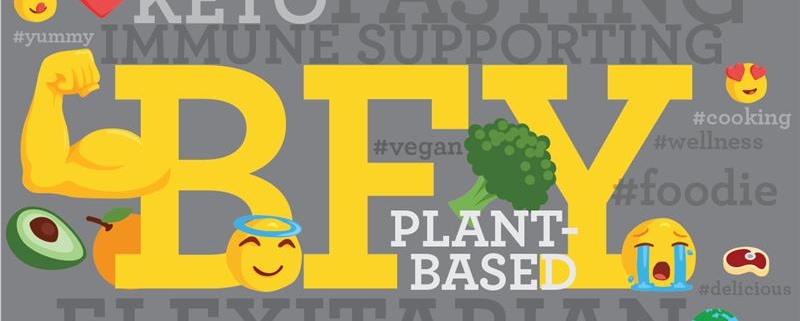5 New Better-For-You Themes Emerging During COVID-19
We’ve been keeping a watchful eye on the better-for-you audience throughout the pandemic. Early on, we saw a decline in better-for-you search interest and social media conversation, but we were impressed by how quickly the health-conscious audience resumed their previous behaviors. In fact, conversation and search levels are now similar to what we saw last summer. But don’t let that fool you into thinking that things haven’t actually evolved over the past several months.
Seed’s social reality tool—which looks into search, social and other digital data from across the web—has helped us identify 5 new better-for-you themes that have our attention.
1. The Evolution of Keto
When we started looking at the Keto diet in the early stages of the pandemic, we suspected that the diet’s “it” moment may be coming to an end. The term “Keto” had been in consistent decline throughout 2020, and the first two weeks of the pandemic accelerated that downward trend. However, as people began to revert back to their prior behaviors, online interest indicated that Keto was one of the few diets that was actually able to rebound. Whether it’s due to resolving issues in the meat supply chain, a plethora of articles on Keto’s potential to protect against COVID-19 or treat virus-related symptoms, or consumers’ desire to address their “Quarantine 15” weight gain, there is renewed, but evolving interest in the Keto diet.
Online conversation is now showing that Keto is shifting from being the “it” diet to becoming a dietary approach with staying power. And with that shift comes diversification in how it is being leveraged. In fact, we are now seeing the emergence of two specific goal-related subsegments within the diet: Health-Driven Keto and Easy Keto.
Looking first at the Health-Driven Keto approach, there have been studies for years about potential benefits that go beyond weight loss—promising everything from better skin to increased brain function to protection against cancer—so it’s not surprising to see more people embracing Keto for benefits beyond weight loss. Many people in this camp refer to their approach as “clean keto” or “strict keto,” where the diet is a vehicle for a health-conscious lifestyle with a focus on whole, nutrient-dense foods and a greater emphasis on food quality.
The second subsegment, the Easy Keto group, focuses on easy weight loss, with less of a focus on overall health. This group’s social posts and online searches often refer to “dirty keto,” “lazy keto,” and “keto supplements.” Though people in this group still follow the diet’s approach to macronutrients, the food sources they choose aren’t always nutritious.
From an innovation standpoint, Keto enthusiasts will be particularly drawn to great-tasting, Keto-compliant foods that also fit their busy, on-the-go schedules.
2. The Rise of Fasting
We recently came across a study showing that intermittent fasting is now the most common diet in the U.S. When we started digging into the “whys” behind it, we found that this practice is tailor-made to address many of the tensions associated with the current environment.
We all know that being stuck at home has caused people to struggle with portion control and over-indulging in comfort foods. The simple concept of intermittent fasting allows people to keep eating what they want, as long as they exercise some control over when they eat it. (We anticipate that this is something that will continue to make intermittent fasting attractive in a post-pandemic world.) It also produces results without requiring extra store trips or negatively impacting already-stretched budgets—things many consumers are concerned about right now.
Another advantage to intermittent fasting is that it gives people a chance to exert control over an aspect of their lives—something that can be very attractive when the world is filled with so much uncertainty.
When thinking about innovation and unmet needs, intermittent fasters will be drawn to better-for-you solutions that promise nutrient density and extended satiety. There’s also a significant opportunity to customize offerings toward specific fasting cycles—like pre-fasting and post-fasting.
3. The Growth of Healthy Snacking
With everyone staying home—and close to their kitchens—we saw a spike in snacking that began early in the pandemic and continues to this day. (This is especially true with younger consumers, as 41% of those under 35 report an increase in snacking.) And, not surprisingly this snacking spike has also led to some unwanted weight gain, with almost a full one-third of U.S. consumers saying they have put on some extra pounds since March.
Despite the negative consequences, we’re not seeing a trend towards less snacking. (People seem unwilling to walk away from the emotional comfort and boredom relief that they provide.) Instead, we are seeing more people explore new healthy snacking practices—even for occasions traditionally dominated by indulgent options (like road trips, baking/DIY, kids, and late-night cravings). So, people aren’t necessarily looking to snack less frequently; they’re just looking to make better choices when they do snack.
With this in mind, innovators should seek to deliver new offerings that help consumers make healthier swaps, control their portions (beyond traditional on-the-go offerings) and create customizable DIY creations the whole family can enjoy—and of course, do so without making people feel like they are sacrificing too much in terms of flavor and experience.
4. The Need for More Accessible Options
When exploring negative sentiment drivers in the social conversation, we saw many calling out the inaccessibility and inequities in the U.S. food system, notably with better-for-you options. While the idea that healthy diets are a luxury accessible only to those with economic means isn’t necessarily a new one, school closings, conversations on racial inequity and a spike in general food insecurity have fueled renewed interest in this debate.
Better-for-you brands that explore their purpose, act in innovative ways to serve a wide breadth of consumers, and leverage partnerships to help address equitable healthy food challenges will unlock opportunities to make a difference and grow their business at the same time.
5. Increased Interest in Immunity-Supporting Foods
While we aren’t seeing a spike in social listening specifically related to “immunity foods” or “immunity support,” we are seeing a sustained level of conversation and interest related to “immunity” in general, as consumers seek to protect both their families and themselves from COVID-19.
Many of the social media posts we see on this topic discuss diets and foods that improve immunity such as the Ritucharya Diet, plant-based superfoods and immunity-boosting spices like turmeric. We are also seeing an uptick in articles related to how nutrition impacts immunity.
And restaurants are already beginning to incorporate more immunity-supporting ingredients like blueberries into their menu items, while brands ramp up innovation with immunity-boosting foods like avocados.
Marketers can expect interest in the immunity space to endure as the pandemic wears on—and continue afterwards as people look to protect themselves from whatever health threat might come next.
So, as you can see, better-for-you consumers are still out there in large numbers, but they are evolving as they search for ways to adapt a healthier lifestyle during these unique circumstances. We’ll monitor these trends—and any new ones that surface—and be sure to keep you informed about how the better-for you category continues to evolve.
Catherine Salzman is Director Social Science and Analytics at Seed Strategy where she uses her 10+ years of experience across strategic, media and research disciplines to illuminate vibrant stories that compel action and inspire clarity.
Co-authored by Nicki Ciminillo. Nicki is Group Manager, Market Intelligence and Reporting Support at Burke, Inc., where she leads market monitoring and competitive intelligence using secondary research to assist clients in making better-informed decisions.
Edited by Adam Siegel. In addition to being the Editor of The Accelerator, Adam is VP, Creative at Seed Strategy where he draws upon his diverse experience in advertising, research and innovation to craft breakthrough creative and winning concept copy.
Connect with us! Follow Seed Strategy on our LinkedIn, Twitter, Facebook and Instagram pages.






